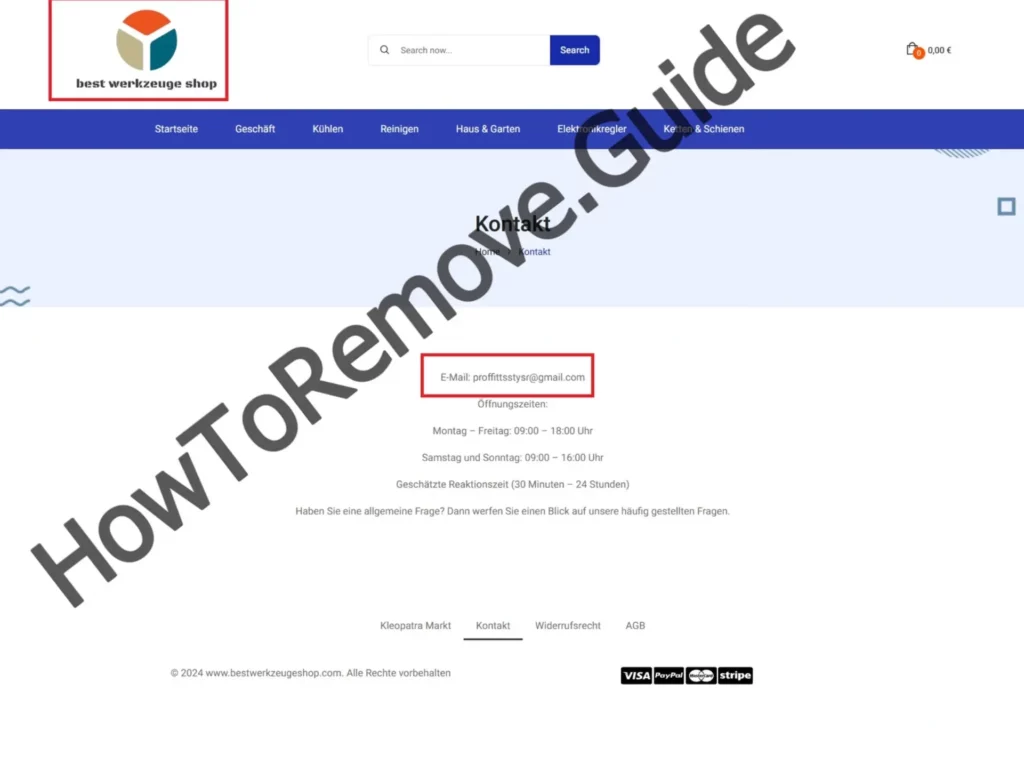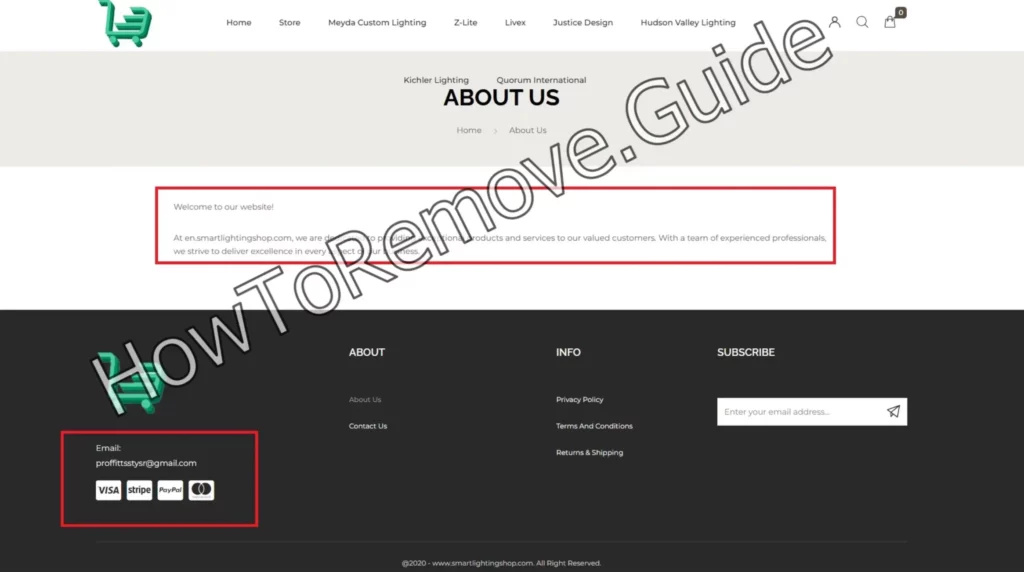Online scams are everywhere and the people behind them have all sorts of ways to lure you in and get you to throw away your money while getting little to nothing in return. The scammers use various types of manipulation techniques and tell blatant lies on their fake sites which tricks users into thinking that there’s an actual good offer waiting for them there.
Such is the case with all sites related to the [email protected] scam email. I am referring to a large group of templated sites that look the same and have an identical purpose – to scam you. The only thing that sets those sites apart is their different URLs, but they are all made by the same people – the scammers that use the [email protected] email.
Some of those sites are bighomelife.com, bestwerkzeugeshop.com, babyshineshop.com, and smartlightingshop.com, but there are many more similar that fall into the same group. Other similar scams we’ve seen in the past are the Easel Enchant Scam and the Xblgo Scam.
If you’ve come across such a site, I urge you to read the next lines where you’ll learn more about this common type of online scam and get important info on how to protect yourself.

What Is the [email protected] Scam?
The [email protected] scam is all about getting you to “think” with your emotions and not with your rational mind. Everyone likes a good deal, so it makes sense that a discounted premium product would grab your attention. The [email protected] scammers simply exploit this psychological tendency:
Unbelievable Deals That Tempt the Unwary
Imagine browsing online and spotting a deal that feels like a once-in-a-lifetime opportunity. A designer handbag for $50, or a high-end smartphone at 80% off. You might think, “How can I pass this up?” That’s precisely the reaction scammers want. These fraudulent websites offer absurdly low prices to bait their victims.
Social Media Advertising at Its Core
Scrolling through Instagram or Facebook, you come across a polished ad for a flash sale. The images are professional, and the description promises massive discounts for a limited time. This strategy hooks shoppers into clicking through to the scam site, where urgency overtakes rational decision-making. The ads seem legitimate, but they’re anything but.

As I already said at the start, there are many, many sites that are linked to [email protected]. Here are the ones I’ve been able to identify thus far:
- bighomelife.com: Reported for selling unauthorized gift cards and other products.
- bestwerkzeugeshop.com: Identified as a scam site offering tools and equipment.
- babyshineshop.com: A fraudulent site purportedly selling baby products.
- smartlightingshop.com: Claimed to offer lighting solutions but is a scam.
- superretailstore.com: Another fraudulent website linked to this email.
- germany-best-coffee.com: Pretends to sell coffee products but is deceptive.
- itlightenstore.com: A scam site offering electronics and lighting products.
- lampedesignstore.com: Fraudulently claims to sell designer lamps.
This is not an exhaustive list so know there are probably many more similar sites out there that you need to be careful with.
What to Do If You’ve Fallen for the [email protected] Scam
Often, there’s not much to be done if you’ve fallen for the [email protected] scam and have purchased something from one of its fake sites. You may have been tricked but you did make a purchase and you did get something in return, albeit of questionable quality. You can try to sue the owners of the site, but it’s hardly worth the hassle.
I do, however, recommend that you perform the following actions to ensure that no more damage comes from this scam. In some cases, the crooks could attempt to compromise your banking accounts since you’ve added your card number on their site. For this reason, do the following ASAP:
Contact Your Bank
If you’ve fallen victim to a scam, take action without delay. Contact your bank to freeze or cancel compromised cards. Request a chargeback for unauthorized transactions. Banks are more likely to assist if informed promptly.
Strengthen Account Security
Change passwords on accounts associated with the scam. Use strong, unique passwords to secure them. Two-factor authentication (2FA) adds another layer of protection, making it harder for unauthorized access.
Run Security Scans on Your Devices
Visiting scam sites or clicking fraudulent links risks malware infections. Run a thorough scan using trusted antivirus software. Early detection prevents further damage.

How the [email protected] Scam Trick You
Most online scams are relatively low effort, but the people behind [email protected] have made some attempts to make the facade of their scheme appear more believable. Here are two major techniques they’ve used to make you think their sites are the real deal:
Fake Trust Badges and Certifications
Websites display symbols resembling security certifications or payment safety badges. These elements trick users into thinking the site is verified. Hovering over these badges reveals the truth—they’re just static images with no functional links or credibility.
Polished Websites With False Testimonials
At a glance, the scam sites look real. Pages are cleanly designed with detailed product descriptions and glowing customer reviews. Everything seems to check out, until you notice inconsistencies. Refund policies sound good but lead nowhere. Contacting customer support is impossible.
It’s like an elaborate façade—convincing until you scratch the surface.

[email protected] Scam Red Flags
Even with the tricks the [email protected] scammers use to mislead you, their scheme is still very easy to spot. The main red flags present in most Internet scams can be seen here too. You just need to know what you should be looking out for:
Limited or Suspicious Contact Options
Legitimate businesses typically provide a phone number, physical address, and multiple ways to reach them. These scam sites rely solely on “[email protected]” as their contact point. A single email as the only option for support should raise immediate concerns.
Newly Created Domains
Checking the age of a website’s domain can be a quick way to gauge credibility. Fraudulent sites often operate on domains created within the past few months. Longstanding businesses don’t spring up overnight with thousands of glowing reviews.
Restricted Payment Methods
Most reputable stores offer secure payment options, like PayPal, which protects buyers in case of fraud. Scam websites, on the other hand, push for direct credit card payments. This approach leaves you with little recourse when things go wrong.
What Happens If You Fall for the [email protected] Scam
Needless to say, numerous users have already been burned by the [email protected] scammers. They’ve purchased something premium from one of their fake sites only to receive a low-quality knock-off product that’s not worth half the paid price. Here are the experiences of two such users:
Electronics That Never Arrive
John, an avid tech enthusiast, ordered a heavily discounted laptop from one of these sites. The deal seemed too good to resist. But instead of receiving the sleek, high-tech device he expected, John got a cheaply made replica. Attempts to contact customer service led nowhere.
Clothing Purchases That Disappear
Emma found a boutique-style Instagram ad for trendy outfits. She placed an order, excited about her find. Weeks passed, but the package never arrived. When Emma tried to revisit the website, it had vanished. She realized she’d been scammed.
Protecting Yourself While Shopping Online
Research Before You Buy
Before placing an order, take a few moments to investigate. Look up reviews on third-party platforms like Trustpilot or Sitejabber. Use search engines to find complaints about the store. Investing time upfront can save significant frustration later.
Insist on Secure Payment Methods
Always use payment methods that offer buyer protection. PayPal or credit cards with fraud protection are safer options. Avoid sites that demand direct transfers or limit payment choices to credit cards only.
Check Domain History
Use tools like WHOIS to check when the website’s domain was registered. A store claiming years of experience shouldn’t have a domain registered three months ago. Skepticism in these scenarios is your best friend.
Trust Your Gut
If something feels off, listen to that instinct. Deals that seem too good to be true rarely are. The uneasy feeling could be your warning signal.
What to Do If You’re Targeted
Ignore Suspicious Links and Messages
Don’t click on links in unsolicited emails or ads that look suspicious. Clicking increases the risk of malware or phishing. Delete the message and move on. Reporting the scam to the platform hosting the ad helps others avoid falling victim.
Report the Incident to Authorities
File complaints with cybersecurity agencies like the Internet Crime Complaint Center (IC3) or local equivalents. Platforms like Facebook and Instagram have systems for reporting fraudulent ads. These actions build databases that aid in tracking and shutting down scammers.
Why Scammers Thrive
Scammers adapt quickly. They abandon websites once complaints pile up and launch new ones under different names. Personal data from breaches helps them tailor scams, making them seem personal and convincing. The cycle continues, forcing users to stay vigilant.
Why Reporting Scams Matters
Protecting Future Victims
By reporting scams, you help create awareness and prevent others from falling into the same trap. Platforms rely on user reports to identify and remove fraudulent operations. Each report strengthens the fight against online fraud.
Building Awareness
Sharing experiences with scams educates others. Raising awareness empowers shoppers to recognize warning signs and avoid becoming victims. Every conversation about scams strengthens the collective defense.
Tips for Long-Term Security
- Use Virtual Credit Cards: Virtual cards reduce risk by generating temporary card numbers for online transactions.
- Enable Transaction Alerts: Real-time notifications alert you to suspicious charges immediately. Acting fast can limit the damage.
- Invest in Identity Protection Services: These services monitor your information and provide recovery assistance if fraud occurs.
The Final Word
Online scams, like those tied to “[email protected],” highlight the need for caution. Shoppers must remain aware, skeptical, and proactive when interacting with unfamiliar sites. Taking time to research, secure your payment methods, and trust your instincts can save you from falling prey.
Your safety online begins with vigilance. Stay informed, stay cautious, and make thoughtful choices every time you shop.

Leave a Reply